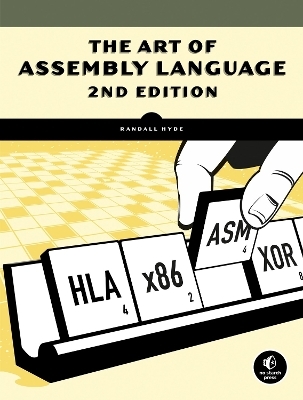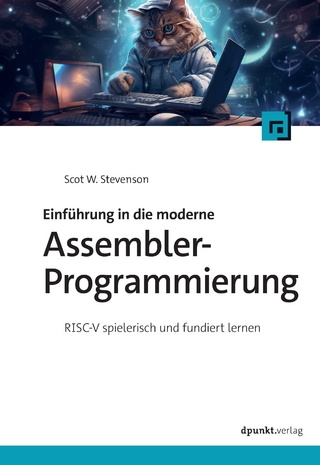
The Art of Assembly Language, 2nd Edition
No Starch Press,US (Verlag)
978-1-59327-207-4 (ISBN)
- Titel wird nachgedruckt
- Versandkostenfrei
- Auch auf Rechnung
- Artikel merken
Randall Hyde is the author of Write Great Code Volumes 1 and 2 (No Starch Press) and the co-author of MASM 6.0 Bible (The Waite Group). He has written for Dr. Dobb's Journal, Byte, and various professional journals. Hyde taught assembly language at the University of California, Riverside for over a decade.
PRAISE FOR THE FIRST EDITION OF THE ART OF ASSEMBLY LANGUAGE; ACKNOWLEDGMENTS;; Chapter 1: HELLO, WORLD OF ASSEMBLY LANGUAGE; 1.1 1.1 The Anatomy of an HLA Program; 1.2 1.2 Running Your First HLA Program; 1.3 1.3 Some Basic HLA Data Declarations; 1.4 1.4 Boolean Values; 1.5 1.5 Character Values; 1.6 1.6 An Introduction to the Intel 80x86 CPU Family; 1.7 1.7 The Memory Subsystem; 1.8 1.8 Some Basic Machine Instructions; 1.9 1.9 Some Basic HLA Control Structures; 1.10 1.10 Introduction to the HLA Standard Library; 1.11 1.11 Additional Details About try..endtry; 1.12 1.12 High-Level Assembly Language vs. Low-Level Assembly Language; 1.13 1.13 For More Information; Chapter 2: DATA REPRESENTATION; 2.1 2.1 Numbering Systems; 2.2 2.2 The Hexadecimal Numbering System; 2.3 2.3 Data Organization; 2.4 2.4 Arithmetic Operations on Binary and Hexadecimal Numbers; 2.5 2.5 A Note About Numbers vs. Representation; 2.6 2.6 Logical Operations on Bits; 2.7 2.7 Logical Operations on Binary Numbers and Bit Strings; 2.8 2.8 Signed and Unsigned Numbers; 2.9 2.9 Sign Extension, Zero Extension, Contraction, and Saturation; 2.10 2.10 Shifts and Rotates; 2.11 2.11 Bit Fields and Packed Data; 2.12 2.12 An Introduction to Floating-Point Arithmetic; 2.13 2.13 Binary-Coded Decimal Representation; 2.14 2.14 Characters; 2.15 2.15 The Unicode Character Set; 2.16 2.16 For More Information; Chapter 3: MEMORY ACCESS AND ORGANIZATION; 3.1 3.1 The 80x86 Addressing Modes; 3.2 3.2 Runtime Memory Organization; 3.3 3.3 How HLA Allocates Memory for Variables; 3.4 3.4 HLA Support for Data Alignment; 3.5 3.5 Address Expressions; 3.6 3.6 Type Coercion; 3.7 3.7 Register Type Coercion; 3.8 3.8 The stack Segment and the push and pop Instructions; 3.9 3.9 The Stack Is a LIFO Data Structure; 3.10 3.10 Accessing Data You've Pushed onto the Stack Without Popping It; 3.11 3.11 Dynamic Memory Allocation and the Heap Segment; 3.12 3.12 The inc and dec Instructions; 3.13 3.13 Obtaining the Address of a Memory Object; 3.14 3.14 For More Information; Chapter 4: CONSTANTS, VARIABLES, AND DATA TYPES; 4.1 4.1 Some Additional Instructions: intmul, bound, into; 4.2 4.2 HLA Constant and Value Declarations; 4.3 4.3 The HLA Type Section; 4.4 4.4 enum and HLA Enumerated Data Types; 4.5 4.5 Pointer Data Types; 4.6 4.6 Composite Data Types; 4.7 4.7 Character Strings; 4.8 4.8 HLA Strings; 4.9 4.9 Accessing the Characters Within a String; 4.10 4.10 The HLA String Module and Other String-Related Routines; 4.11 4.11 In-Memory Conversions; 4.12 4.12 Character Sets; 4.13 4.13 Character Set Implementation in HLA; 4.14 4.14 HLA Character Set Constants and Character Set Expressions; 4.15 4.15 Character Set Support in the HLA Standard Library; 4.16 4.16 Using Character Sets in Your HLA Programs; 4.17 4.17 Arrays; 4.18 4.18 Declaring Arrays in Your HLA Programs; 4.19 4.19 HLA Array Constants; 4.20 4.20 Accessing Elements of a Single-Dimensional Array; 4.21 4.21 Sorting an Array of Values; 4.22 4.22 Multidimensional Arrays; 4.23 4.23 Allocating Storage for Multidimensional Arrays; 4.24 4.24 Accessing Multidimensional Array Elements in Assembly Language; 4.25 4.25 Records; 4.26 4.26 Record Constants; 4.27 4.27 Arrays of Records; 4.28 4.28 Arrays/Records as Record Fields; 4.29 4.29 Aligning Fields Within a Record; 4.30 4.30 Pointers to Records; 4.31 4.31 Unions; 4.32 4.32 Anonymous Unions; 4.33 4.33 Variant Types; 4.34 4.34 Namespaces; 4.35 4.35 Dynamic Arrays in Assembly Language; 4.36 4.36 For More Information; Chapter 5: PROCEDURES AND UNITS; 5.1 5.1 Procedures; 5.2 5.2 Saving the State of the Machine; 5.3 5.3 Prematurely Returning from a Procedure; 5.4 5.4 Local Variables; 5.5 5.5 Other Local and Global Symbol Types; 5.6 5.6 Parameters; 5.7 5.7 Functions and Function Results; 5.8 5.8 Recursion; 5.9 5.9 Forward Procedures; 5.10 5.10 HLA v2.0 Procedure Declarations; 5.11 5.11 Low-Level Procedures and the call Instruction; 5.12 5.12 Procedures and the Stack; 5.13 5.13 Activation Records; 5.14 5.14 The Standard Entry Sequence; 5.15 5.15 The Standard Exit Sequence; 5.16 5.16 Low-Level Implementation of Automatic (Local) Variables; 5.17 5.17 Low-Level Parameter Implementation; 5.18 5.18 Procedure Pointers; 5.19 5.19 Procedural Parameters; 5.20 5.20 Untyped Reference Parameters; 5.21 5.21 Managing Large Programs; 5.22 5.22 The #include Directive; 5.23 5.23 Ignoring Duplicate #include Operations; 5.24 5.24 Units and the external Directive; 5.25 5.25 Namespace Pollution; 5.26 5.26 For More Information; Chapter 6: ARITHMETIC; 6.1 6.1 80x86 Integer Arithmetic Instructions; 6.2 6.2 Arithmetic Expressions; 6.3 6.3 Logical (Boolean) Expressions; 6.4 6.4 Machine and Arithmetic Idioms; 6.5 6.5 Floating-Point Arithmetic; 6.6 6.6 Converting Floating-Point Expressions to Assembly Langggggguage; 6.7 6.7 HLA Standard Library Support for Floating-Point Arithmetic; 6.8 6.8 For More Information; Chapter 7: LOW-LEVEL CONTROL STRUCTURES; 7.1 7.1 Low-Level Control Structures; 7.2 7.2 Statement Labels; 7.3 7.3 Unconditional Transfer of Control (jmp); 7.4 7.4 The Conditional Jump Instructions; 7.5 7.5 "Medium-Level" Control Structures: jt and jf; 7.6 7.6 Implementing Common Control Structures in Assembly Language; 7.7 7.7 Introduction to Decisions; 7.8 7.8 State Machines and Indirect Jumps; 7.9 7.9 Spaghetti Code; 7.10 7.10 Loops; 7.11 7.11 Performance Improvements; 7.12 7.12 Hybrid Control Structures in HLA; 7.13 7.13 For More Information; Chapter 8: ADVANCED ARITHMETIC; 8.1 8.1 Multiprecision Operations; 8.2 8.2 Operating on Different-Size Operands; 8.3 8.3 Decimal Arithmetic; 8.4 8.4 Tables; 8.5 8.5 For More Information; Chapter 9: MACROS AND THE HLA COMPILE-TIME LANGUAGE; 9.1 9.1 Introduction to the Compile-Time Language (CTL); 9.2 9.2 The #print and #error Statements; 9.3 9.3 Compile-Time Constants and Variables; 9.4 9.4 Compile-Time Expressions and Operators; 9.5 9.5 Compile-Time Functions; 9.6 9.6 Conditional Compilation (Compile-Time Decisions); 9.7 9.7 Repetitive Compilation (Compile-Time Loops); 9.8 9.8 Macros (Compile-Time Procedures); 9.9 9.9 Writing Compile-Time "Programs"; 9.10 9.10 Using Macros in Different Source Files; 9.11 9.11 For More Information; Chapter 10: BIT MANIPULATION; 10.1 10.1 What Is Bit Data, Anyway?; 10.2 10.2 Instructions That Manipulate Bits; 10.3 10.3 The Carry Flag as a Bit Accumulator; 10.4 10.4 Packing and Unpacking Bit Strings; 10.5 10.5 Coalescing Bit Sets and Distributing Bit Strings; 10.6 10.6 Packed Arrays of Bit Strings; 10.7 10.7 Searching for a Bit; 10.8 10.8 Counting Bits; 10.9 10.9 Reversing a Bit String; 10.10 10.10 Merging Bit Strings; 10.11 10.11 Extracting Bit Strings; 10.12 10.12 Searching for a Bit Pattern; 10.13 10.13 The HLA Standard Library Bits Module; 10.14 10.14 For More Information; Chapter 11: THE STRING INSTRUCTIONS; 11.1 11.1 The 80x86 String Instructions; 11.2 11.2 Performance of the 80x86 String Instructions; 11.3 11.3 For More Information; Chapter 12: CLASSES AND OBJECTS; 12.1 12.1 General Principles; 12.2 12.2 Classes in HLA; 12.3 12.3 Objects; 12.4 12.4 Inheritance; 12.5 12.5 Overriding; 12.6 12.6 Virtual Methods vs. Static Procedures; 12.7 12.7 Writing Class Methods and Procedures; 12.8 12.8 Object Implementation; 12.9 12.9 Constructors and Object Initialization; 12.10 12.10 Destructors; 12.11 12.11 HLA's _initialize_ and _finalize_ Strings; 12.12 12.12 Abstract Methods; 12.13 12.13 Runtime Type Information; 12.14 12.14 Calling Base Class Methods; 12.15 12.15 For More Information; ASCII CHARACTER SET; COLOPHON; UPDATES;
| Verlagsort | San Francisco |
|---|---|
| Sprache | englisch |
| Maße | 178 x 234 mm |
| Themenwelt | Informatik ► Programmiersprachen / -werkzeuge ► Assembler |
| ISBN-10 | 1-59327-207-3 / 1593272073 |
| ISBN-13 | 978-1-59327-207-4 / 9781593272074 |
| Zustand | Neuware |
| Informationen gemäß Produktsicherheitsverordnung (GPSR) | |
| Haben Sie eine Frage zum Produkt? |
aus dem Bereich
